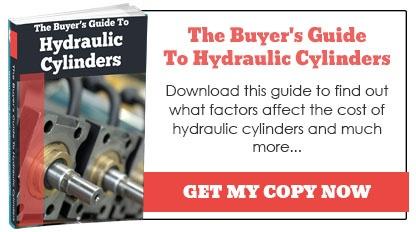
Have you ever asked yourself “How do hydraulic cylinders work?” To understand how a hydraulic cylinder works it is useful to look first at the basic components of a simple hydraulic cylinder.
These will usually include:
- Cylinder Barrel - This component is made from a polished tube of seamless steel and plays a vital role in maintaining cylinder pressure.
- Cylinder Base Or Cap - This closes off the hydraulic cylinder at one end. The cap will usually be connected to the barrel by welding or tie rod. Caps may also be used to assist with mounting the cylinder. There will usually be a static seal or O-ring between the cap and the barrel.
- Cylinder Head - This encloses the hydraulic cylinder at the other end. The head contains an integrated piston arm sealing arrangement. The head is usually connected to the barrel by tie rods. A static seal or O-ring links the head and the barrel.
- Hydraulic Fluid - This is usually an oil that will be able to withstand the pressure and temperature requirements for the operation of the cylinder.
- Piston - The piston will be a finely manufactured metal component to fit neatly inside the cylinder. A primary function is to be a barrier that will keep the two different pressure zones inside the barrel separated. It is this difference in applied pressure that makes the piston move within the barrel.
- Piston Rod - The piston rod is polished metal and is attached to the piston. It needs to extend out of the cylinder through the head. The piston rod connects the hydraulic cylinder to whatever mechanism is doing the work. The piston rod must be polished so that it provides a protective seal to solid materials and liquid contaminants from entering the cylinder from outside.
- Seals - The cylinder is fitted with strong seals, as when the hydraulic fluid is under pressure it is important to ensure no contaminants can get in. There is a dynamic seal on the piston rod to allow it to move in and out of the cylinder. The piston inside the cylinder will have seals around it and pushing against the internal cylinder wall, to help keep the pressure zones fully differentiated. There will also be bearings to facilitate the movement of the piston within the barrel.
How Do Hydraulic Cylinders Work?
It is a simple matter of pressure. The hydraulic fluid is placed under pressure; which is then applied to the piston. The size of the diameter of the piston will alter the level of force that is exerted on it by the pressure from the hydraulic fluid. If it has a larger diameter there will be more pressure and the result will be a more powerful cylinder.
The difference in pressure for the piston inside the cylinder forces it to move. There will be fail-safes in the system so that when the pressure continues to be applied to a cylinder and it has reached the end of the space, a pressure release valve relieves the pressure and the piston is able to move again.
The piston rod must be firmly connected to the piston so it moves with inside the cylinder. Outside the cylinder, the rod is attached to whatever it is making it move, which could be industrial machinery or excavation equipment.
What Are Hydraulic Cylinders For?
The simple concept of how hydraulic cylinders work means they can generate a lot of force so that they are effective when heavy loads are involved.
There are many varieties that have different purposes and capabilities, as well as a range of designs to suit your design requirements. If you have a specific need then a supplier such as ourselves will be able to manufacture bespoke components for you. If you need any more information on how a hydraulic cylinder works, please download our Buyer’s Guide To Hydraulic Cylinders by clicking here.






